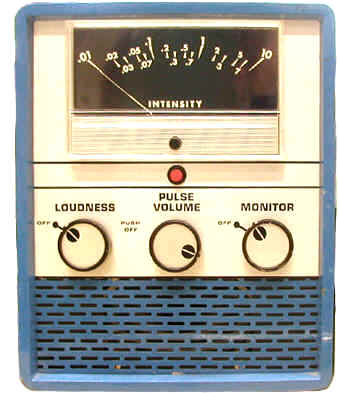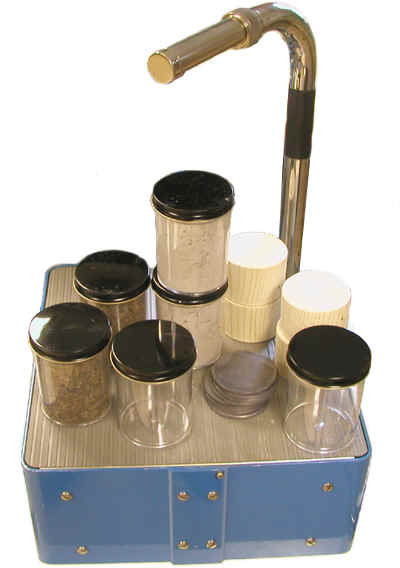CD V-757 Barrier Shielding Demonstrator Set (ca. 1962-1968)

The above photograph shows (left to right): two remote speakers, the tower remote indicator, portable microphone, instrument console, and the base unit with GM detector. An extension for the GM probe is in front of the monitor and platform. The photograph below shows a close up of the monitor.

Quoting the FEMA publication Radiological Defense Manual (CPG 2-6.2), the CD V-757 was "a low-range radiation detection instrument coupled to a neon-lighted remote readout indicator that is readily visible in large conference rooms or small auditoriums. With the large indicator, a lecturer can show how radiation from a radioactive source is affected by distance and shielding. A small amount of cesium 137 [one millicurie of cesium-137 which required a license for possession and use], which gives off gamma rays, is housed in a lead ball mounted in the demonstration platform. A hole in the platform leads to the cesium source, and gamma radiation is beamed vertically. The aperture is normally closed by a tungsten plug which is padlocked in position. Mounted directly over the hole is a Geiger Muller tube that is in the radiation beam when the tungsten plug is removed."

By placing a radiation absorbing material over the platform hole, the intensity of the radiation beam is attenuated, resulting in a lower exposure rate readout. Comparison of radiation absorbing materials can readily be made by placing them in the radiation beam."

The absorbing materials (see photo right) consisted of eight lead disks, two plastic jars filled with concrete, two plastic jars filled with soil, two empty plastic jars (for water), and four cylinders of wood. The wood cylinders are one half the height of the jars. As such, the two jars of concrete, soil, or water will stack up to the same height as the wood. The eight lead disks stack up to a height of one inch. The absorbers in the photo are duplicates of those that came with the CD V-757.
The photograph to the left shows the neon tube display of the remote indicator. As the detector's count rate increases, the neon light climbs up the logarithmic scale. The light is easily seen with the room lights on, but the photo was taken in the dark for the effect.
According to Radiological Instruments: An Essential Resource for National Preparedness (CPG 3-1), only 81 of these were procured. As of 1985, 55 of these were in state inventories and 25 were in the federal inventory.
The CD V-757 was used in presentations given to law enforcement, firefighters, emergency responders, radiological defense (RADEF) personnel, and occasionally the general public.
Approximate Cumulative Procurement, Inventory and Distribution of CD V-757s*
| Fiscal Year | Procured | Inventoried | Distributed |
|---|---|---|---|
| FY 1965 | - | - | - |
| FY 1966 | 81 | - | - |
| FY 1967 | 81 | 48 | 33 |
| FY 1968 | 81 | 35 | 46 |
| FY 1969 | 81 | 32 | 49 |
| FY 1970 | 81 | 29 | 52 |
| FY 1971 | 81 | 26 | 55 |
| FY 1972 | 81 | 28 | 52 |
| FY 1973 | 81 | ||
| FY 1974 | 81 | 19 | 62 |
*The numbers in the above table should be considered approximate. I compiled them from data in the Annual Statistical Reports of the OCDM, OCD and DCPA. By "procured," I mean delivered by the manufacturer to the OCDM, OCD or DCPA. "Inventoried" means stored in a Federal (rather than state) warehouse ready for distribution. "Distributed" means sent to the end user. The latter primarily means the states, but also various federal agencies and even foreign governments. The number of procured instruments may be greater than the combined number of inventoried and distributed instruments for a variety of reasons: some may have been sent back to the manufacturer, some may have been disposed of, the numbers might be incorrect, etc.
References
- Victoreen Instrument Company. Instruction and Maintenance manual. Barrier Shielding Demonstrator Set OCD Item No. CD V-757, Model 1. No date.
- Office of Civil Defense. Suggested Lecture for use with the Barrier Shielding Demonstrator Set. No Publication number or date.
- Federal Emergency Management Agency, Radiological Instruments: An Essential Resource for National Preparedness, CPG 3-1, September. 1986.
- Defense Civil Preparedness Agency, Department of Defense. CPG 2-6.2. Radiological Defense Manual. June 1977.
- Rich Faulkner with the State of Nebraska. Personal communication.

What material is best to protect against radiation? This demonstration will show you.
The CD V-757 was used for lectures and demonstrations educating audiences on the best materials to protect against radiation exposure.
